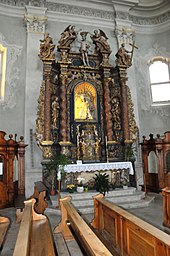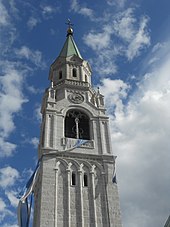Philip and James (Cortina d'Ampezzo)
The Basilica of Saints Philip and James (it. Basilica Parrocchiale SS. Filippo e Giacomo ) is on Corso Italia in the center of the Venetian city of Cortina d'Ampezzo . Pope Benedict XVI gave her the title of Basilica minor in 2011 .
history
The church was built between 1769 and 1775 in Baroque style according to plans by the Gadertal architect G. Promperg-Costa. It thus took up the space that an earlier church, probably also of Gothic style, occupied and which was demolished for the new building. In the years 2007 to 2009 the church was extensively restored. The work was carried out under the direction of the architect Gianluca Ghedini, at the request of the parish dean Francesco De Luca and his successor Davide Fiocco.
description
Portal and interior
The church is built in a NW-SE orientation, the chancel (10) is in the southeast. There is also the separately built bell tower (18). The portal forms the center of the baroque facade and has two turrets (1). Above it are two stone statues by an unknown Venetian artist, depicting the two patron saints Philip and James (the younger) (the latter mistakenly decorated with the insignia of the elder ). If you step through the portal, you will find a nave with only a few and shallow niches on the walls, in which only the four side altars (12, 13, 14, 15) stand out. The ship is exposed to light through the large windows. The floor was laid from dolomite tiles in 2007 , using the historical pattern based on old photos. The replacement of the heating and renewal of electrical lines gave rise to the laying of a new floor.
painting
If you now look to the sides, you see the frescoes “Saints Rochus and Sebastian ” (2) and “The sermon of St. John the Baptist ”(3), both works of art by Giuseppe Ghedina (1825–1898), who lived and worked in Cortina d'Ampezzo. On the ceiling of the nave there is a fresco painting by the painter Franz Anton Zeiller (1716–1794), who became known through numerous works in Tyrolean and Bavarian churches , which he carried out from 1774 to 1775. Above the viewer, at the beginning of the nave, are the “Martyrdom of St. James ”(4) and“ The Expulsion of the Merchants from the Temple ”(5) in the penultimate and“ The Martyrdom of St. Philip ”in the last ceiling section in front of the chancel. There are also other works of art by Zeiller: 14 Stations of the Cross, which start at the right entrance portal (7); two large paintings with biblical motifs in the presbytery: "Esther von Assuero" (8) ( Esther 5,1-14 EU ) and "The Judgment of Solomon " (9) ( 1 Kings 3 : 16–28 EU ). The pictures painted over in 1859 were exposed again in 1929. Giuseppe Ghedina is also the artist of the work “The Holy Trinity” (10) from 1859 in the vault of the presbytery.
Altars
Main altar
In 1773 Johann Mussack jr. (1745–1793) the main altar (11) made of wood with stuccolustro decoration with the six angels and the two statues of Peter and Paul . Already 94 years earlier (1679) Antonio Zanchi (1631–1722) created the altarpiece with “Virgin Mary and the Holy. Philip and James ”. Giuseppe Lacedelli (1754-1832) from Cortina d'Ampezzo then added the local coat of arms to the altarpiece. The bas-relief above the altar is a work of the " Immaculate Virgin Mary " by Peter Höpfner , created in 1773 , from whose workshop the processional cross on the pillar next to the choir stalls and the two precious confessionals that used to stand next to the main entrance are now in Sanctuary.
Side altars
The two front side altars (12, 13) made of wooden imitation marble, which are decorated with two statues of saints, also come from Müssack. It is believed that the relics under the right altar (12) come from Bishop Liberius . The altarpiece shows the “St. Josef with the child ”by Giuseppe Ghedina, the picture below is probably from his son.
In the left altar (13) one suspects the relics of a “St. Theophilus ”, probably Theophilus of Caesarea . The painter Luigi Gillarduzzi (1822–1856) from Cortina d'Ampezzo was commissioned by the community to create the altarpiece of the “ Mother of Sorrows ”.
The two oldest altars, which still come from the previous church, are in the central niches (14, 15). On the altar of the “Madonna del Carmine” (14) is a painted, gilded wooden sculpture. The altarpiece is assigned to the Bellunese painter Antonio Lazzarini (1672–1732). It shows the “Our Lady gives the sashes to St. Teresa of Avila , Simon Stock and Peter of Alcantara ”.
On the other side (15) is the altar of the "Mother of God of the Rosary", which was created from 1703 in the workshop of the Bellunese sculptor Andrea Brustolon (1662–1732). This altar was the main altar in the previous church and contained the altarpiece by Zanchi that is in the main altar today. Today the niche houses a statue of the Virgin Mary from the Brixen School from the beginning of the 16th century. The tabernacle and probably also the statues of Philip and Jacob are independent works by Brustolon .
Above the side entrance, next to the side altar (13), hangs the pulpit (without number) made of wood and stucco by an otherwise unknown Silvestro di Mai from Cortina. The valuable chandelier with 12 lamps (formerly candles) hanging in front of it in the middle of the room comes from Venice in the 18th century.
organ
The organ from the workshop of the Mauracher company was installed in 1954, but it was not the first organ in the church:
- The first organ came from a master who is unknown today and dates back to 1561.
- The second was created by an organ builder named Franz Knecht from Brixen in 1703.
- In 1777 the famous Gaetano Callido (1727-1813) built the third organ. It had 18 registers .
- The penultimate organ from the company Zachistal & Capek from Krems followed in 1885 .
- In 1954 Mauracher installed the current organ.
Bell tower
The history of the free-standing bell tower (18) goes back to 1590, when a previous tower stood here. After the bells were broken several times in the newly built tower and rock fell from the tower onto the street in 1846, the bells were mounted on a twelve-meter-high wooden tower on the forecourt of the church. The local entrepreneur Silvestro Franceschi had the tower demolished in 1849 and immediately fastened the foundation with a pile of 400 larch trunks, covered with stones and gravel. Franceschi's plans were confirmed by the Viennese architect Hermann von Bergmann. The foundation stone was blessed on August 18, 1852. The new construction of the 69.5 meter high tower was completed in 1858, so that the new six bells from the Grassmayr bell foundry in Innsbruck could call to prayer for the first time on Christmas Eve 1858. The total construction costs with the tower clock and bells amounted to the equivalent of around 5 million euros. On the top of the tower there is a gold-plated ball with a diameter of 1 m.
Peal
The tower houses a total of 9 bells that ring in the tune of Big Ben :
- The big bell from 1857 has a diameter of 172.0 cm and a weight of 3,047 (?) Kg. It is one of the largest and most valuable bells in Veneto. It sounds in h 0 .
- The next smallest weighs 1,455 kg and sounds in d 1 .
- The next smallest weighs 860 kg and sounds in f 1 .
- The next smallest weighs 361 kg and sounds in h 1 .
- The next smallest weighs 192 kg and sounds in d 2 .
- The smallest weighs 120 kg and sounds in f 2 .
- Three more bells are there
- the "agony" from the destroyed church of St. Catherine from 1570
- the clockwork bell
- the fire guard's bell
It is thanks to the intervention of Emperor Charles I that the bells did not suffer the same fate as most of the others in the empire: They were not melted down for war purposes. Charles I visited Cortina d'Ampezzo in 1917 on a trip to the theaters of war on the Piave .
Dibona monument
In the middle of the main square directly in front of the church is the monument of the Ampezzaner mountain guide, emperor hunter and Dolomite pioneer Angelo Dibona , erected in 1976, and a bronze plaque from 2011 on the visit of Emperor Maximilian in 1511.
literature
- Church prospectus
Web links
Individual evidence
Coordinates: 46 ° 32 ′ 14.6 ″ N , 12 ° 8 ′ 11 ″ E





